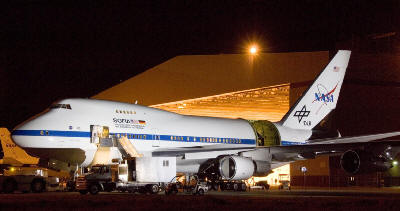
SOFIA, the Stratospheric Observatory For Infrared Astronomy (SOFIA) is a flying infrared observatory. With this unique platform, scientists will be able to investigate for example the development of young stars and planetary systems or to examine the centre of our home galaxy, the Milky Way.
The major part of the infrared light of these celestial objects cannot penetrate the earth atmosphere due to the absorption of its water vapour. For this reason the German Aerospace Centre (DLR) and the National Aeronautics and Space Administration (NASA) started the SOFIA project for which a Boeing 747-SP was highly modified and equipped with a German telescope in the rear of the aircraft, weighing 17 tons and having a primary mirror diameter of 2.7 meter. In an altitude of about 13 kilometres the atmospheric influence on star observations is negligible, and hence observers will have an undisturbed view onto the infrared sky. SOFIA will presumably start with scientific observations in late 2009, which is the International Year of Astronomy.
The German contribution to the project is the development, construction and testing of the telescope which is the heart of the observatory. At the intended aircraft altitude of SOFIA, the telescope will be placed in a highly unprofitable environment for precise observations. For example the aero acoustic loads on the telescope due to the open cavity of a size of about 3 x 3 metres as well as the vibrations of the aircraft itself will stimulate vibrations of the whole structure. In order to guarantee that the required pointing stability is met by the observatory, these effects have to be known and controlled well. Hence engineers from the German SOFIA Institute (DSI) at the Universitaet Stuttgart , which operates the SOFIA telescope on behalf of DLR need to derive the exact dynamical parameters of the telescope.
The ARTeMIS software from Structural Vibration Solutions A/S provides the best possibility to investigate structures like the SOFIA telescope under its realistic operation conditions. For that ARTeMIS does not depend on the use of well defined, artificial signals for the stimulation, but takes advantage of those provided by the actual disruptions like the wind loads and aircraft vibration itself. With that approach the DSI engineers can determine the stimulated telescope vibrations that occur during real observing conditions and investigate for example their dependence from the cavity temperature which is about minus 40 degrees Celsius.
SOFIA, the “Stratospheric Observatory for Infrared Astronomy” is a joint project of the German Space Agency (German Aerospace Centre, DLR) and the National Aeronautics and Space Administration (NASA). It is funded on behalf of DLR by federal (Bundesministerium für Wirtschaft), state (Baden-Württemberg) and University (Stuttgart) means. Scientific operation for Germany is coordinated by the “Deutsches SOFIA-Institut” (DSI) of Stuttgart University, in USA by Universities Space Research Association (USRA).
Palle Andersen
Managing Director, Ph.D.
Niels Jernes Vej 10
9220 Aalborg East, Denmark
